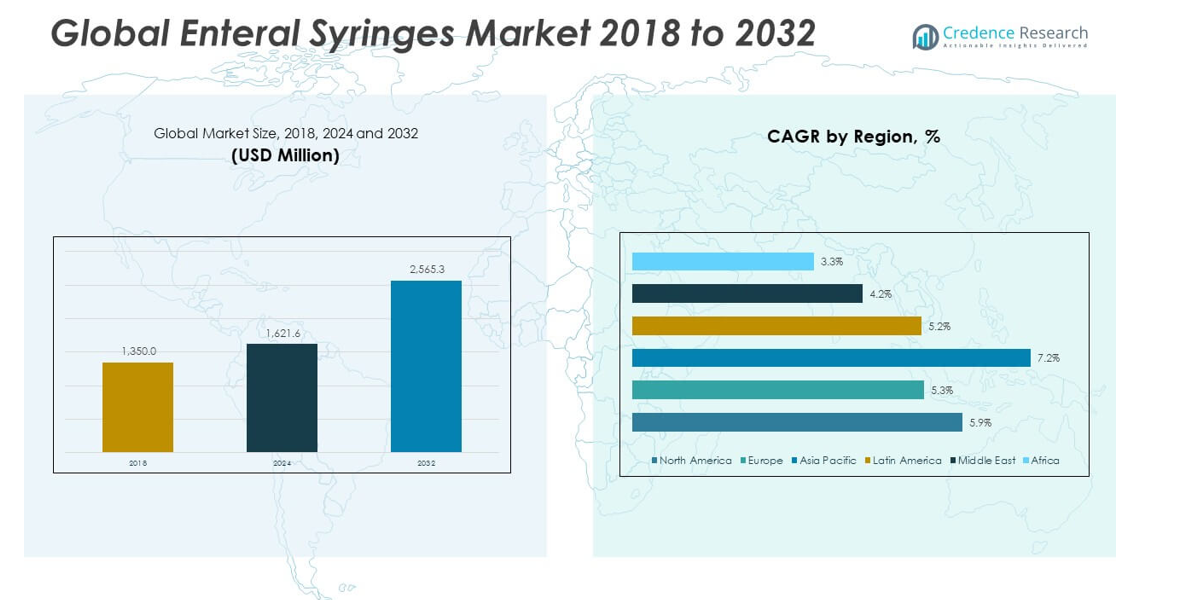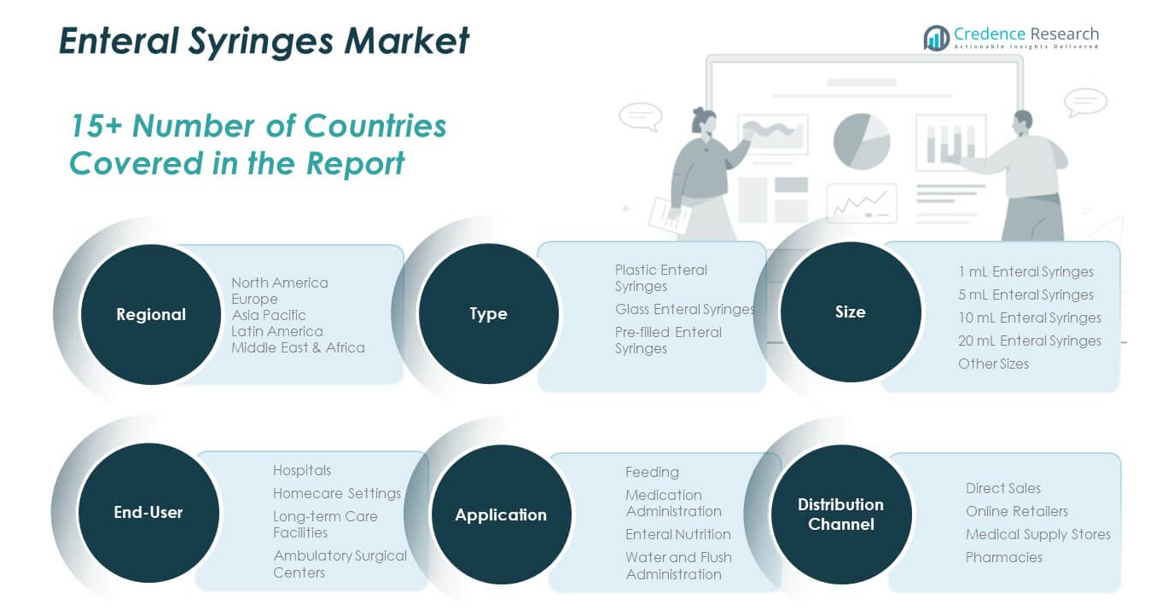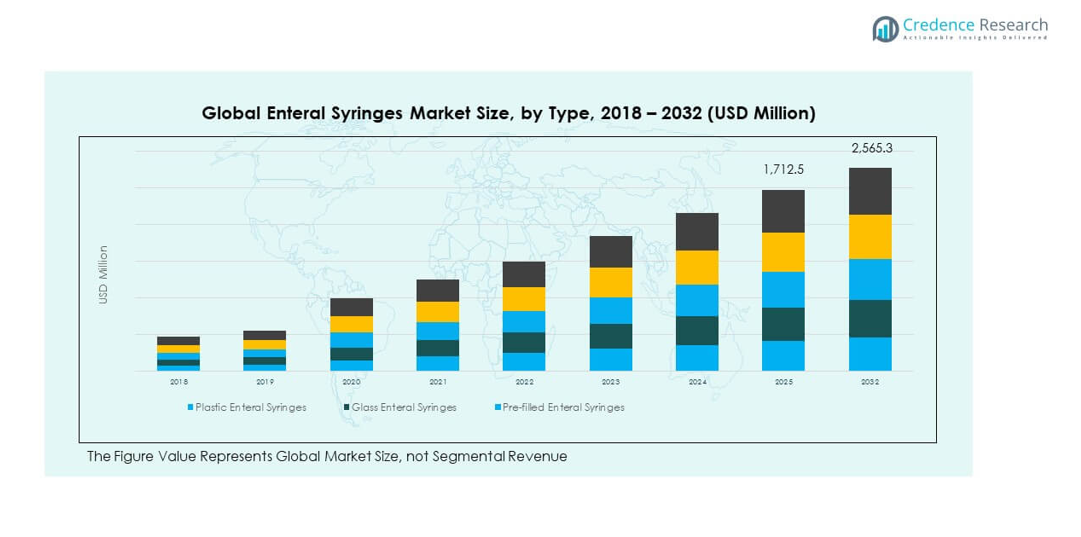CHAPTER NO. 1 : GENESIS OF THE MARKET
1.1 Market Prelude – Introduction & Scope
1.2 The Big Picture – Objectives & Vision
1.3 Strategic Edge – Unique Value Proposition
1.4 Stakeholder Compass – Key Beneficiaries
CHAPTER NO. 2 : EXECUTIVE LENS
2.1 Pulse of the Industry – Market Snapshot
2.2 Growth Arc – Revenue Projections (USD Million)
2.3. Premium Insights – Based on Primary Interviews
CHAPTER NO. 3 : ENTERAL SYRINGES MARKET FORCES & INDUSTRY PULSE
3.1 Foundations of Change – Market Overview
3.2 Catalysts of Expansion – Key Market Drivers
3.2.1 Momentum Boosters – Growth Triggers
3.2.2 Innovation Fuel – Disruptive Technologies
3.3 Headwinds & Crosswinds – Market Restraints
3.3.1 Regulatory Tides – Compliance Challenges
3.3.2 Economic Frictions – Inflationary Pressures
3.4 Untapped Horizons – Growth Potential & Opportunities
3.5 Strategic Navigation – Industry Frameworks
3.5.1 Market Equilibrium – Porter’s Five Forces
3.5.2 Ecosystem Dynamics – Value Chain Analysis
3.5.3 Macro Forces – PESTEL Breakdown
3.6 Price Trend Analysis
3.6.1 Regional Price Trend
3.6.2 Price Trend by product
CHAPTER NO. 4 : KEY INVESTMENT EPICENTER
4.1 Regional Goldmines – High-Growth Geographies
4.2 Product Frontiers – Lucrative Product Categories
4.3 Application Sweet Spots – Emerging Demand Segments
CHAPTER NO. 5: REVENUE TRAJECTORY & WEALTH MAPPING
5.1 Momentum Metrics – Forecast & Growth Curves
5.2 Regional Revenue Footprint – Market Share Insights
5.3 Segmental Wealth Flow – Type & Application Revenue
CHAPTER NO. 6 : TRADE & COMMERCE ANALYSIS
6.1. Import Analysis by Region
6.1.1. Global Enteral Syringes Market Import Revenue By Region
6.2. Export Analysis by Region
6.2.1. Global Enteral Syringes Market Export Revenue By Region
CHAPTER NO. 7 : COMPETITION ANALYSIS
7.1. Company Market Share Analysis
7.1.1. Global Enteral Syringes Market: Company Market Share
7.2. Global Enteral Syringes Market Company Revenue Market Share
7.3. Strategic Developments
7.3.1. Acquisitions & Mergers
7.3.2. New Product Launch
7.3.3. Regional Expansion
7.4. Competitive Dashboard
7.5. Company Assessment Metrics, 2024
CHAPTER NO. 8 : ENTERAL SYRINGES MARKET – BY TYPE SEGMENT ANALYSIS
8.1. Enteral Syringes Market Overview by Type Segment
8.1.1. Enteral Syringes Market Revenue Share By Type
8.2. Plastic Enteral Syringes
8.3. Glass Enteral Syringes
8.4. Pre-filled Enteral Syringes
CHAPTER NO. 9 : ENTERAL SYRINGES MARKET – BY APPLICATION SEGMENT ANALYSIS
9.1. Enteral Syringes Market Overview by Application Segment
9.1.1. Enteral Syringes Market Revenue Share By Application
9.2. Feeding
9.3. Medication Administration
9.4. Enteral Nutrition
9.5. Water and Flush Administration
CHAPTER NO. 10 : ENTERAL SYRINGES MARKET – BY END-USER SEGMENT ANALYSIS
10.1. Enteral Syringes Market Overview by End-user Segment
10.1.1. Enteral Syringes Market Revenue Share By End-user
10.2. Hospitals
10.3. Homecare Settings
10.4. Long-term Care Facilities
10.5. Ambulatory Surgical Centers
CHAPTER NO. 11 : ENTERAL SYRINGES MARKET – BY SIZE SEGMENT ANALYSIS
11.1. Enteral Syringes Market Overview by Size Segment
11.1.1. Enteral Syringes Market Revenue Share By Size
11.2. 1 mL Enteral Syringes
11.3. 5 mL Enteral Syringes
11.4. 10 mL Enteral Syringes
11.5. 20 mL Enteral Syringes
11.6. Other Sizes
CHAPTER NO. 12 : ENTERAL SYRINGES MARKET – BY DISTRIBUTION CHANNEL SEGMENT ANALYSIS
12.1. Enteral Syringes Market Overview by Distribution Channel Segment
12.1.1. Enteral Syringes Market Revenue Share By Distribution Channel
12.2. Direct Sales
12.3. Online Retailers
12.4. Medical Supply Stores
12.5. Pharmacies
CHAPTER NO. 13 : ENTERAL SYRINGES MARKET – REGIONAL ANALYSIS
13.1. Enteral Syringes Market Overview by Region Segment
13.1.1. Global Enteral Syringes Market Revenue Share By Region
13.1.2. Regions
13.1.3. Global Enteral Syringes Market Revenue By Region
13.1.4. Type
13.1.5. Global Enteral Syringes Market Revenue By Type
13.1.6. Application
13.1.7. Global Enteral Syringes Market Revenue By Application
13.1.8. End-user
13.1.9. Global Enteral Syringes Market Revenue By End-user
13.1.10. Size
13.1.12. Global Enteral Syringes Market Revenue By Size
13.1.13. Distribution Channel
13.1.14. Global Enteral Syringes Market Revenue By Distribution Channel
CHAPTER NO. 14 : NORTH AMERICA ENTERAL SYRINGES MARKET – COUNTRY ANALYSIS
14.1. North America Enteral Syringes Market Overview by Country Segment
14.1.1. North America Enteral Syringes Market Revenue Share By Region
14.2. North America
14.2.1. North America Enteral Syringes Market Revenue By Country
14.2.2. Type
14.2.3. North America Enteral Syringes Market Revenue By Type
14.2.4. Application
14.2.5. North America Enteral Syringes Market Revenue By Application
14.2.6. End-user
14.2.7. North America Enteral Syringes Market Revenue By End-user
14.2.8. Size
14.2.9. North America Enteral Syringes Market Revenue By Size
14.2.10. Distribution Channel
14.2.11. North America Enteral Syringes Market Revenue By Distribution Channel
14.3. U.S.
14.4. Canada
14.5. Mexico
CHAPTER NO. 15 : EUROPE ENTERAL SYRINGES MARKET – COUNTRY ANALYSIS
15.1. Europe Enteral Syringes Market Overview by Country Segment
15.1.1. Europe Enteral Syringes Market Revenue Share By Region
15.2. Europe
15.2.1. Europe Enteral Syringes Market Revenue By Country
15.2.2. Type
15.2.3. Europe Enteral Syringes Market Revenue By Type
15.2.4. Application
15.2.5. Europe Enteral Syringes Market Revenue By Application
15.2.6. End-user
15.2.7. Europe Enteral Syringes Market Revenue By End-user
15.2.8. Size
15.2.9. Europe Enteral Syringes Market Revenue By Size
15.2.10. Distribution Channel
15.2.11. Europe Enteral Syringes Market Revenue By Distribution Channel
15.3. UK
15.4. France
15.5. Germany
15.6. Italy
15.7. Spain
15.8. Russia
15.9. Rest of Europe
CHAPTER NO. 16 : ASIA PACIFIC ENTERAL SYRINGES MARKET – COUNTRY ANALYSIS
16.1. Asia Pacific Enteral Syringes Market Overview by Country Segment
16.1.1. Asia Pacific Enteral Syringes Market Revenue Share By Region
16.2. Asia Pacific
16.2.1. Asia Pacific Enteral Syringes Market Revenue By Country
16.2.2. Type
16.2.3. Asia Pacific Enteral Syringes Market Revenue By Type
16.2.4. Application
16.2.5. Asia Pacific Enteral Syringes Market Revenue By Application
16.2.6. End-user
16.2.7. Asia Pacific Enteral Syringes Market Revenue By End-user
16.2.8. Size
16.2.9. Asia Pacific Enteral Syringes Market Revenue By Size
16.2.10. Distribution Channel
16.2.11. Asia Pacific Enteral Syringes Market Revenue By Distribution Channel
16.3. China
16.4. Japan
16.5. South Korea
16.6. India
16.7. Australia
16.8. Southeast Asia
16.9. Rest of Asia Pacific
CHAPTER NO. 17 : LATIN AMERICA ENTERAL SYRINGES MARKET – COUNTRY ANALYSIS
17.1. Latin America Enteral Syringes Market Overview by Country Segment
17.1.1. Latin America Enteral Syringes Market Revenue Share By Region
17.2. Latin America
17.2.1. Latin America Enteral Syringes Market Revenue By Country
17.2.2. Type
17.2.3. Latin America Enteral Syringes Market Revenue By Type
17.2.4. Application
17.2.5. Latin America Enteral Syringes Market Revenue By Application
17.2.6. End-user
17.2.7. Latin America Enteral Syringes Market Revenue By End-user
17.2.8. Size
17.2.9. Latin America Enteral Syringes Market Revenue By Size
17.2.10. Distribution Channel
17.2.11. Latin America Enteral Syringes Market Revenue By Distribution Channel
17.3. Brazil
17.4. Argentina
17.5. Rest of Latin America
CHAPTER NO. 18 : MIDDLE EAST ENTERAL SYRINGES MARKET – COUNTRY ANALYSIS
18.1. Middle East Enteral Syringes Market Overview by Country Segment
18.1.1. Middle East Enteral Syringes Market Revenue Share By Region
18.2. Middle East
18.2.1. Middle East Enteral Syringes Market Revenue By Country
18.2.2. Type
18.2.3. Middle East Enteral Syringes Market Revenue By Type
18.2.4. Application
18.2.5. Middle East Enteral Syringes Market Revenue By Application
18.2.6. End-user
18.2.7. Middle East Enteral Syringes Market Revenue By End-user
18.2.8. Size
18.2.9. Middle East Enteral Syringes Market Revenue By Size
18.2.10. Distribution Channel
18.2.11. Middle East Enteral Syringes Market Revenue By Distribution Channel
18.3. GCC Countries
18.4. Israel
18.5. Turkey
18.6. Rest of Middle East
CHAPTER NO. 19 : AFRICA ENTERAL SYRINGES MARKET – COUNTRY ANALYSIS
19.1. Africa Enteral Syringes Market Overview by Country Segment
19.1.1. Africa Enteral Syringes Market Revenue Share By Region
19.2. Africa
19.2.1. Africa Enteral Syringes Market Revenue By Country
19.2.2. Type
19.2.3. Africa Enteral Syringes Market Revenue By Type
19.2.4. Application
19.2.5. Africa Enteral Syringes Market Revenue By Application
19.2.6. End-user
19.2.7. Africa Enteral Syringes Market Revenue By End-user
19.2.8. Size
19.2.9. Africa Enteral Syringes Market Revenue By Size
19.2.10. Distribution Channel
19.2.11. Africa Enteral Syringes Market Revenue By Distribution Channel
19.3. South Africa
19.4. Egypt
19.5. Rest of Africa
CHAPTER NO. 20 : COMPANY PROFILES
20.1. B. Braun Melsungen
20.1.1. Company Overview
20.1.2. Product Portfolio
20.1.3. Financial Overview
20.1.4. Recent Developments
20.1.5. Growth Strategy
20.1.6. SWOT Analysis
20.2. BD
20.3. Cardinal Health
20.4. Terumo
20.5. Koninklijke Philips
20.6. Thermo Fisher Scientific
20.7. GBUK Enteral
20.8. Baxter International
20.9. Vygon SA










